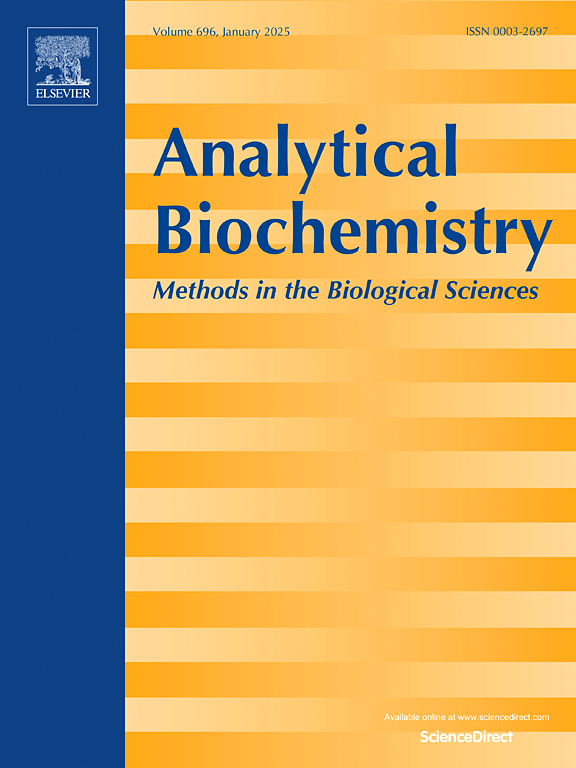Colorimetric and fluorescent dual-modality assay for cell-free mitochondrial DNA copy number in saliva
IF 2.6
4区 生物学
Q2 BIOCHEMICAL RESEARCH METHODS
引用次数: 0
Abstract
Copy number of cell-free mitochondrial DNA (cf-mtDNA) has garnered significant attention as a biomarker for studying and diagnosing various diseases. However, Quantitative Real-time PCR (qPCR) and Droplet Digital PCR (ddPCR) assays for cf-mtDNA copy number detection require expensive equipment and high experiment conditions. In this study, a colorimetric and fluorescent dual-modality assay was developed for quantitative detection of cf-mtDNA copy number. With G-quadruplex (G4) sequence modified primers, the assay could quantitatively detect cf-mtDNA with spectrophotometry, RGB (Red, Green, Blue) visual method and fluorescence method, which made the application scenarios more diverse. The specificity of dual-mode method was better, and the detection limits of spectrophotometry, RGB visual method and fluorescence method were as low as 1.45 × 10−1 copies/μL, 1.65 copies/μL and 1.58 × 10−1 copies/μL, respectively. Compared with qPCR and ddPCR assays developed in previous studies, the dual-modality assay in this study had a lower detection limit. It was also independent of expensive qPCR and ddPCR equipment and the detection cost was low. Therefore, the colorimetric and fluorescent dual-modality assay represent a label-free and sensitive approach for assessing cf-mtDNA levels, offering promising implications for biomedical research and clinical diagnostics.

唾液中无细胞线粒体DNA拷贝数的比色和荧光双模分析
无细胞线粒体 DNA(cf-mtDNA)拷贝数作为研究和诊断各种疾病的生物标志物,已引起人们的极大关注。然而,用于检测 cf-mtDNA 拷贝数的定量实时 PCR(qPCR)和液滴数字 PCR(ddPCR)检测方法需要昂贵的设备和较高的实验条件。本研究开发了一种比色和荧光双模式检测方法,用于定量检测 cf-mtDNA 拷贝数。该检测方法采用 G-quadruplex (G4) 序列修饰引物,可通过分光光度法、RGB(红、绿、蓝)可视法和荧光法对 cf-mtDNA 进行定量检测,应用场景更加广泛。双模式方法的特异性更好,分光光度法、RGB 视觉法和荧光法的检测限分别低至 1.45 × 10-1 拷贝/μL、1.65 拷贝/μL 和 1.58 × 10-1 拷贝/μL。与以往研究中开发的 qPCR 和 ddPCR 检测方法相比,本研究中的双模式检测方法的检测限更低。同时,它也不受昂贵的 qPCR 和 ddPCR 设备的影响,检测成本低。因此,比色和荧光双模式检测是一种无标记、灵敏的 cf-mtDNA 水平评估方法,为生物医学研究和临床诊断提供了广阔的前景。
本文章由计算机程序翻译,如有差异,请以英文原文为准。
求助全文
约1分钟内获得全文
求助全文
来源期刊

Analytical biochemistry
生物-分析化学
CiteScore
5.70
自引率
0.00%
发文量
283
审稿时长
44 days
期刊介绍:
The journal''s title Analytical Biochemistry: Methods in the Biological Sciences declares its broad scope: methods for the basic biological sciences that include biochemistry, molecular genetics, cell biology, proteomics, immunology, bioinformatics and wherever the frontiers of research take the field.
The emphasis is on methods from the strictly analytical to the more preparative that would include novel approaches to protein purification as well as improvements in cell and organ culture. The actual techniques are equally inclusive ranging from aptamers to zymology.
The journal has been particularly active in:
-Analytical techniques for biological molecules-
Aptamer selection and utilization-
Biosensors-
Chromatography-
Cloning, sequencing and mutagenesis-
Electrochemical methods-
Electrophoresis-
Enzyme characterization methods-
Immunological approaches-
Mass spectrometry of proteins and nucleic acids-
Metabolomics-
Nano level techniques-
Optical spectroscopy in all its forms.
The journal is reluctant to include most drug and strictly clinical studies as there are more suitable publication platforms for these types of papers.
 求助内容:
求助内容: 应助结果提醒方式:
应助结果提醒方式:


